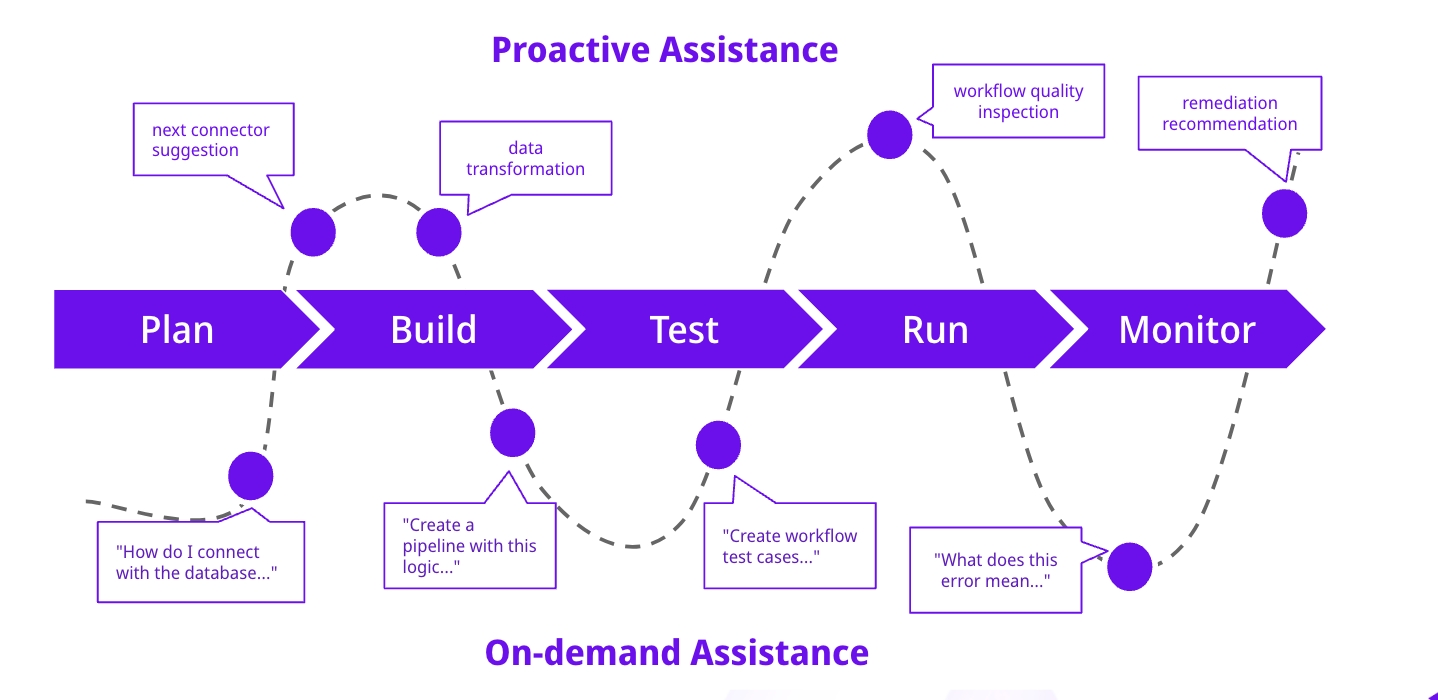AI Pair Programmer
Learn more about what the AI Pair Programmer is on the Digibee Integration Platform.
Overview
AI Pair Programmer is an innovative approach that revolutionizes the development process by providing developers with an AI-powered assistant specifically designed to increase their productivity and efficiency. AI acts as a real-time co-developer, proactively providing assistance, suggesting code improvements, and automating routine tasks throughout the development process.
Whether you are planning, building, testing, or deploying your project, AI Pair Programmer provides valuable insights, optimizes workflows, and helps resolve potential issues before they arise. By seamlessly integrating into your development environment, AI not only accelerates your progress, but also increases your expertise, makes complex tasks more manageable and improves the overall outcome of the project.
How it works
Our AI Pair Programmer solution is designed to fit seamlessly into the developer's workflow, providing both proactive and reactive assistance throughout the entire integration development journey.
The AI acts as a collaborative partner, offering insights and solutions without having to be explicitly prompted. This ensures that developers are always one step ahead. By supplementing developers' actions with contextual suggestions, optimizing workflows, and integrating best practices, the AI not only helps complete tasks, but also promotes continuous learning by educating developers along the way.
The AI Pair Programmer interacts with the user in two ways: through proactive assistance by anticipating the user's needs and automatically offering help at critical touchpoints, and through reactive assistance by responding to user-initiated requests in chat whenever they need it.

Proactive assistance
Proactive assistance is provided throughout the entire journey. The AI takes the initiative at critical touchpoints to identify challenges and provide timely support. Some examples of assistance include:
Guidance and recommendations: the AI can anticipate challenges and opportunities and provides best practices, architecture recommendations, and warnings of potential risks before they become problems.
Automated task execution: the AI can proactively automate routine tasks such as code generation and error detection, reducing manual effort and speeding up the development process.
Real-time optimization: during development, the AI can suggest optimal configurations, design patterns, and performance improvements, helping to streamline workflows and improve results.
On-demand assistance
On-demand assistance is always available throughout the journey. Users can request help at any time using the integrated chat. The AI responds immediately and provides the necessary assistance exactly when and where it is needed, ensuring that developers can overcome obstacles and continue working smoothly. Some examples of assistance are:
Support: developers can ask for assistance at any time and receive immediate help with tasks such as debugging, testing, and performance optimization.
Knowledge-based guidance: the AI provides contextual information and best practices when developers are faced with complex decisions, enabling them to make informed choices.
Issue resolution: When issues arise, the AI is ready to help troubleshoot and offer solutions based on real-time analysis and previous project experience.
Key benefits
Our AI Pair Programmer solution offers several core benefits that significantly improve the development process, making it more efficient, reliable, and conducive to continuous learning and improvement.
Higher productivity
Reduced bottlenecks: sharing knowledge and responsibility with AI minimizes development bottlenecks. The AI helps distribute tasks and responsibilities, ensuring a smooth workflow without unnecessary delays.
Continuous progress: constant monitoring by the AI ensures that the pace of development is maintained. Potential blockers are quickly identified and addressed, allowing teams to maintain momentum throughout the project lifecycle.
Complexity reduction: the AI eliminates the need for highly specialized skills by providing expert guidance and automation. This allows developers to focus on the core aspects of their projects without being hindered by technical complexity.
Enhanced code quality
Error reduction: the AI continuously reviews the code as it is written, catching errors at an early stage before they can cause significant problems. This proactive error detection improves the overall stability and reliability of the codebase.
Increased consistency: by ensuring that all developers adhere to best practices and standards, AI promotes consistency across multiple projects and users. This leads to more uniform and maintainable code, regardless of which team or person is working on it.
Knowledge sharing
Skills development: developers benefit from working with the AI, which not only assists with tasks, but also trains them. Over time, developers improve their integration and platform-specific skills, resulting in a more capable and knowledgeable team.
Consistent knowledge: the AI shares its knowledge of the codebase with the entire team, ensuring that knowledge does not remain isolated to individual developers. This creates a collaborative environment where everyone is on the same page.
Improved problem-solving
Diverse perspectives: the AI brings different perspectives and approaches to problem-solving, leading to more robust and comprehensive solutions. This diversity in thinking helps to approach challenges from different angles, which often leads to more innovative results.
Immediate feedback: developers receive immediate feedback on their work, allowing for quick fixes and iterative improvements. This real-time feedback loop speeds up the development process and increases the overall quality of the final product.
Features and capabilities
The AI Pair Programmer is fully embedded in our Platform and integrates seamlessly into every aspect of the development process to provide comprehensive support and enhancements. While any type of assistance can be requested through chat, proactive assistance is woven throughout the entire Digibee Integration Platform to ensure developers receive timely, contextualized guidance every step of the way.
To fully understand the extensive AI capabilities offered by the AI Pair Programmer, we recommend reading the detailed product documentation on our Platform. The documentation contains detailed information on how each feature works, how AI integrates with various tools and workflows, and best practices for maximizing the benefits of the AI Pair Programmer.
Was this helpful?